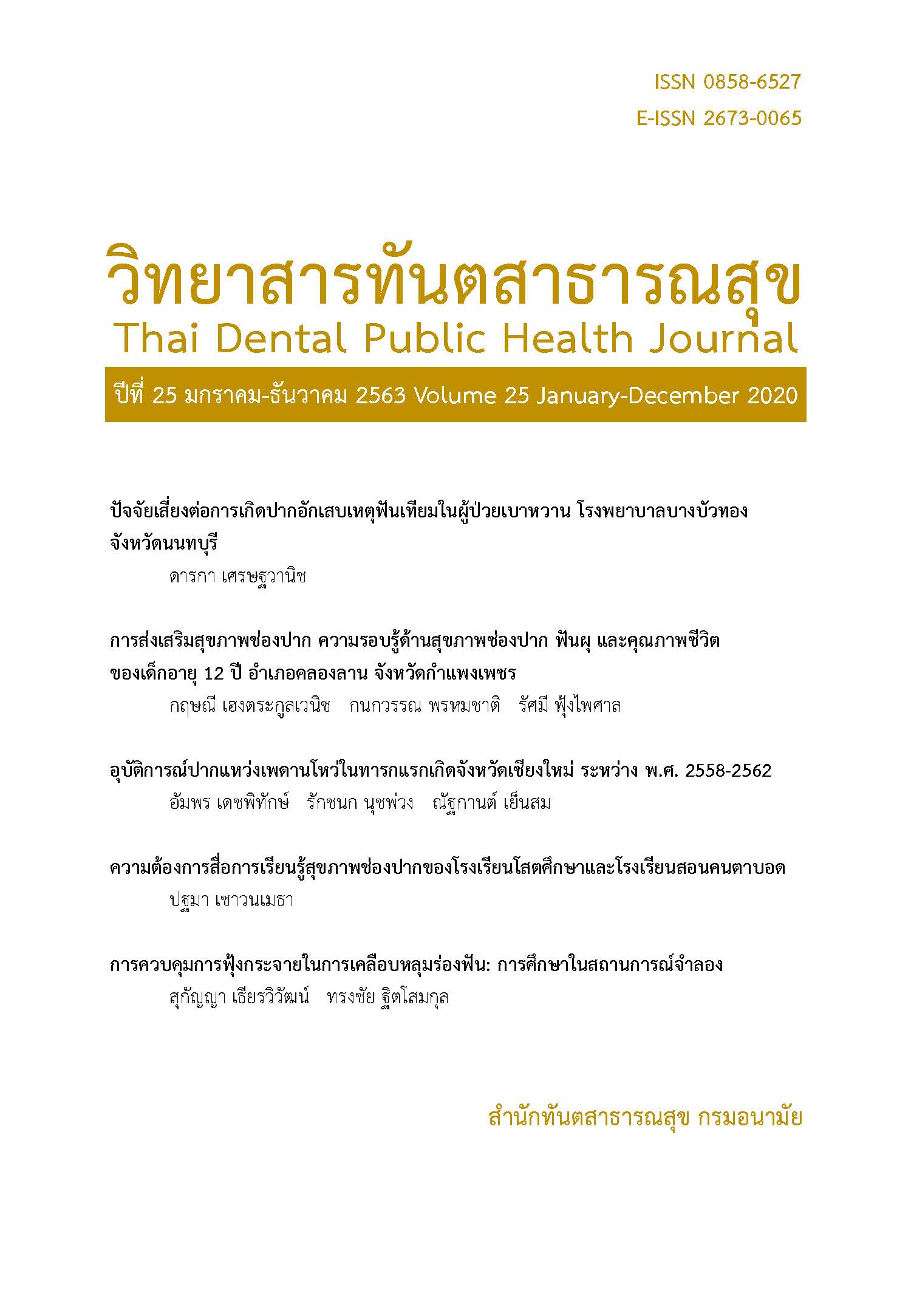Demand of disabled deaf and blind schools for oral health education media
Main Article Content
Abstract
This descriptive study explored the situation and media needs of 34 audiovisual and blind schools performed during July and September 2018 by mailing the survey and telephone interviewed in case the information is not sent back in time. The data were analyzed by descriptive statistics such as frequency, percentage and content grouping.
There were responses from 20 audiovisual schools (95.2 percent), 11 blind schools (84.6 percent). Audiovisual schools use the most dental model (70.0 percent of the total school population) and wanted multimedia media the most (85.0 percent). Blind schools used braille media the most (81.8 percent) and 81.8 percent wanted embossed picture book and dental model the most.
Downloads
Article Details
References
Social Statistics Bureau. Summary results of Disability Survey 2017. Bangkok: National Statistical Office; 2017.
Social Statistics Bureau. Summary results of Disability Survey 2012. Bangkok: National Statistical Office; 2012.
World Health Organization. World report on disability [online]. 2016 [cited 2017 December 18]. Available from: http://who. int/disabilities/world_report/2011/factsheet.pdf?ua=1.
Department of Empowerment of Persons with Disabilities. Report on the situation of persons with disabilities in Thailand [online]. 30 Sep 2020 [cited 2020 Oct 9]. Available from: http://dep.go.th/Content/ View/6615/1
Piyasilpa W, Ningsanon W. Visual disability. In Piyasilpa W, Ningsanon W, (eds). Children with Disabilities. Bangkok: Royal College of Pediatricians of Thailand; 2015. p. 17-32.
Buvaneswari B, Hemalatha T, Kalaivani G, Pavithra P, Preethisree AR. Communication among blind, deaf and dumb People, International Journal of Advanced Engineering, Management and Science (IJAEMS). 2020; 6(4): 173-176.
Permvattana R, Hollier S. Where e-learning dental models and social media collide: supporting the future education of blind and VI learners. [online] 16 December 2013; Available from: https://www.w3.org/ WAI/RD/2013/e-learning/paper1/.
Royal Gazette. Announcement of the Ministry of Education Re: Types and criteria for educational disabilities B.E. 2552. Nonthaburi: Ministry of Education 2009.
Manarungvit K. Smile Student Desk for handicapped children, Academic Journal: Faculty of Architecture, Khon Kaen University. 2012; 11: 142-7.
Sawetsuporn S. Memory capability and interrogative suggestibility of normal children compared to deaf children and blind children [Degree of Master of Arts Program in Applied Psychology Thesis]. Bangkok: Chulalongkorn University; 2011.
Apisitsuksonti S. Exhibition media design for visually impaired in Bangkok Local Museum [Degree of Master of Arts Program in Design Arts Thesis]. Bangkok: Silpakorn University; 2015.
Nilsook P. Educational technology for the blind. Journal of Technical Education Development. 2003; 47: 58-62.
Sopapornamorn P, Samphatsim P, Tamma P, Chimruang J and Kosum T. An audio dentoform: tooth-brushing teaching for visual impaired people. Th Dent PH J. 2018; 23(1): 60-8.
Sharififard N, Sargeran K, Gholami M, Zayeri F. A music- and game-based oral health education for visually impaired school children; multilevel analysis of a cluster randomized controlled trial. BMC Oral Health 2020; 20: 144 https://doi.org/10.11 86/s12903-020-01131-5.
Nadagaddi SB, Patil NG, Honnamude NL. Effectiveness of Audio-Assisted Teaching Programme on healthy life style activities among visually impaired children of selected blind school at Vijayapur. International Journal of Health Sciences and Research, 2020; 10: 79-84.
Ulfa DA, Narawati T. Creative dance for teaching motor skills for the blind students. Advances in Social Science, Education and Humanities Research, 2019; 419: 23-5.
UNC Computer Science. BATS: The blind audio tactile mapping system. [online]. [2020 Apr 11]; Available from: URL: http:// citeseerx.ist.psu.edu/viewdoc/download?doi=10.1.1.10.6189&rep=rep1&type=pdf (in Thai)
Wanichsaithong P, Chompikul J, Mongkolchati A, Chatiketu P. Predictors of dental service utilization among visual impaired people in Chiang Mai, Thailand, Journal of Public Health and Development. 2015;13: 1-15.
Rocha LL, de Lima Saintrain MV, Vieira-Meyer APGF. Access to dental public services by disabled persons. BMC Oral Health. 2015; 15: 35. doi: 10.1186/s12903-015-0022-x.
Sandeep V, Vinay C, Madhuri V, Veerabhadra RV, Uloopi KS, Chandra SR. Impact of visual instruction on oral hygiene status of children with hearing impairment. Journal of Indian Society of Pedodontics and Preventive Dentistry. 2014; 32: 39-43.
Somboon P, Chaichanheng S, Jitwiriyatham T, Yoksuriyont S. Research and development of multimedia media teaching Thai sign language in facility technology. Educational Research Journal Faculty of Education, Srinakharinwirot University. 2015; 9: 116-30.
Kumsiri T, Saejaeo T, Wicha S. Research and development project program to teach sign language with 3D animation to promote learning potential of Thai-English vocabulary of students with hearing impairment: a case study at Anusarn Sunthorn School for the Deaf, Chiang Mai University: 2010.
Dental Public Health Bureau. Oral health learning materials Chao Chao doll teaches teeth brushing & manual book. [online] 23 August 2019 [cited 2020 Sep 16]; Available from: URL: http://dental2. anamai.moph.go.th/download/download/onepage.jpg
Costa C, Marcelino L, Neves J, Sousa C. Games for education of deaf students- a
systematic literature review. ECGBL19 Proceedings, 2018; 170-81.
Wijayanti D, Bayu Kurniawan VR. Needs assessment of Indonesian language learning competencies for deaf students. Proceedings of the 1st International conference on science and technology for an internet of things, 2018. doi:10.4108/eai.19-10-2018.2281358.
Sathitwittayanan P. Storybook design to promote visualization for visually impaired children. Bangkok: Silpakorn University; 2003.
Intharaprasong A, Aswanich P, Sakulpongyuenyong S. Methods for teaching teeth brushing in blind children: research report. Bangkok: Chulalongkorn University; 1998.


